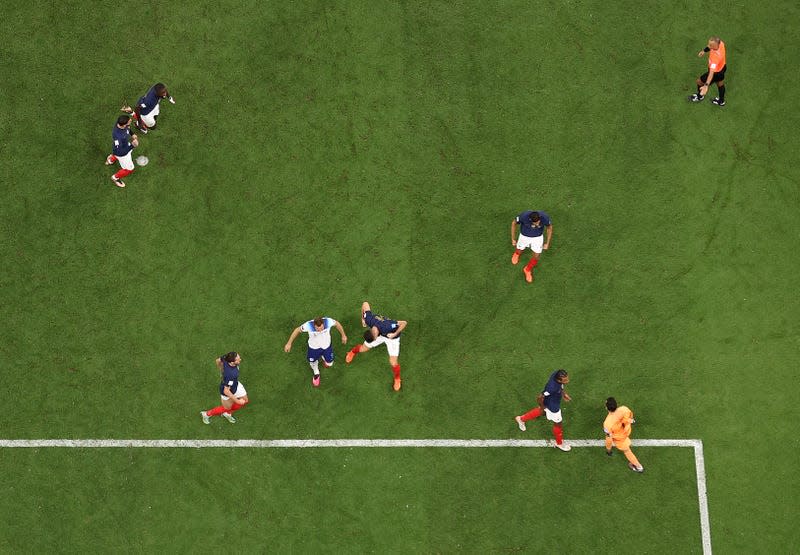How a Georgia company grew the grass for the World Cup—and then flew it to Qatar

The perfect grass for a soccer field is deep green and sharply striped, and mowed to the exact length—23mm—for optimal speed of play for the ball. Beyond that, features may vary.
It takes teams of expert agronomists years of research and testing to determine the right grass for a World Cup stadium’s conditions. This year, the grass that won the World Cup contract is called PlatinumTE Paspalum, grown by a Georgia-based company called Atlas Turf International.
Read more
“It’s nerve-wracking,” Atlas Turf CEO John Holmes said, not of the nail-biting unpredictability of a tournament where legacy giants have fallen to victorious underdogs, but of the grass on pitch. Atlas Turf’s paspalum is planted across all eight of the World Cup’s stadiums and 81 practice fields. If something goes wrong, it would reflect badly on their marquee grass’ performance.
“You don’t want to see anyone get injured,” Holmes said, as he watches the matches on screen.
A good turf grass provides stability, with tightly packed blades and deep roots that keep the players’ feet from sliding out from under them as they run at speed and stop on a dime. Holmes watches for clods of turf flying around and assesses the goal line, which sees some of the hardest wear on the pitch. During corner kicks, he watches for signs of death—the corners get the least sun and can be the hardest to keep alive. So far, he says, the grass is holding up well.
This tournament is the largest world stage Atlas Turf’s grass has been tested in, and among the toughest conditions. It’s a window into the future of grass, one that needs less water and carbon-emitting fertilizer than other types of grass, for fields and golf courses around the world, as the climate become more inhospitable.
A grass for an inhospitable climate
Qatar, a desert nation not known for its verdant meadows or babbling brooks, has three main challenges: water, air and light. “You’ve got almost every condition going against you there,” Holmes said.
The water used to irrigate the grass is low quality. It’s either treated sewage or desalinated seawater. Because of the blazing desert sun, Qatar’s stadiums were built for maximum shade—great for preventing heatstroke, but less ideal for photosynthesis. Inside the nearly-closed stadiums, there’s very little air movement. Atlas Turf’s paspalum was chosen as much for its appearance, as its tolerance for the tough conditions: salty water, stagnant air, and low light.
How to make grass bloom in the desert
A grass that can survive bad water, little light, and dead air, is not a naturally occurring grass, but it is descended from one: seashore paspalum, a tropical grass with high salt tolerance. This grass was then bred for specific traits, including color and root length, by researchers who created generations of increasingly specialized, individually patented paspalum turf grass.
Atlas Turf’s paspalum was developed by a plant breeder named Ron Duncan, who patented several types of grasses at the University of Georgia. After going into private practice, he developed what would become Atlas Turf’s PlatinumTE Paspalum in 2007, differentiated from previous iterations by its disease tolerance and a thicker leaf blade.
Atlas Turf grows its grass in Adel, a town of about 5,000 people in southern Georgia. At 90 days, the stolons, or sprigs of grass, are harvested, washed, packed into boxes and shipped by refrigerated air cargo to Doha.
The first shipment went to Al-Rayyan Stadium in 2014. Over the next few years, Atlas Turf sent a total of 305,000 pounds of stolen to Doha. There, the grass is planted in fields next to each stadium until the individual sprigs knit together into a field. They are then rolled up transferred to inside the stadiums, and unrolled into the equivalent of 178 acres of field.
Lower inputs for a changing world
In some ways, Qatar is a proving ground for the future of turf grasses in a hotter, drought-stricken world less hospitable to grasses and most living things in general.
Much of what’s driven turf grass development in recent years, Holmes said, has been preparation for a climate changed world by breeding grasses that require fewer inputs, of water, pesticides, and fertilizer, one of the world’s biggest drivers of carbon emissions. Atlas Turf’s paspalum, Holmes said, uses about 25% to 30% less water than other grasses, depending on conditions, can live off of 3 pounds of fertilizer where a Bermudagrass may need 14 to 15 pounds.
It’s an improvement, but turf grasses themselves are more likely to be part of the problem than the solution.
In Qatar, creating the conditions that will keep the grass alive is carbon-intensive. Manufactured cooled air needs to be pumped directly onto the turf, and according to a report by Reuters, each pitch requires more than 2,200 gallons of water a day in the winter, and 11,000 gallons a day in the summer. Much of the water is derived from desalination, a fossil fuel-intensive process that damages marine ecosystems. Desalination is a major driver of this World Cup’s carbon footprint.
All together, the World Cup’s fields are slightly larger than the average American golf course, which takes up about 150 acres. In the US, 2 million acres are used for golf courses. Turf grasses, like PlatinumTE Paspalum and others are used to carpet these courses, including in high-maintenance desert landscapes that struggle to naturally support an unblemished field.
More from Quartz
Sign up for Quartz's Newsletter. For the latest news, Facebook, Twitter and Instagram.

